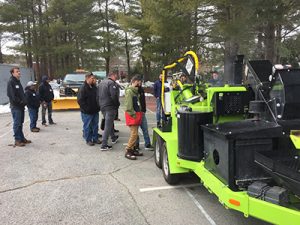Things are starting to heat up outside in many parts of the country, which means the weather is conducive for sealcoating. To execute successfully, you need to select the right sealer formula. That’s because sealer performance is affected by the proportion of the product’s various components. It may sound like complex chemistry, but it doesn’t have to be difficult.
THE BREAKDOWN
Much of asphalt pavement sealers are water-based emulsions that are a mixture of a binder (i.e. refined coal tar, asphalt emulsion, or petroleum distillate), mineral filler (i.e. clay), and water. Many of these pavement sealers are supplied in concentrated form, which require the addition of water, aggregate (sand), and additive (optional) prior to application. The combination of these ingredients is referred to as the “mix design.”
The mix design is the recipe for the ratio in which ingredients are mixed. To help you determine the best mix design for your jobs, we have compiled general guidelines along with suggested adjustments based on pavement requirements or climate conditions.
It is recommended that you use the information as a general guide and experiment to determine what works best for your unique projects and circumstances.
GENERAL GUIDELINES
| Refined Tar | Petroleum Distillate | Asphalt Emulsion | |
| Sealer Concentrate | 100 gal | 100 gal | 100 gal |
| Dilution Water | 30 – 35 gal (30 – 35% by vol. sealer conc.) |
30 – 35 gal (30 – 35% by vol. sealer conc.) |
25 – 30 gal (20 – 30% by vol. sealer conc.) |
| Sand | 200 lb. (2 lb./gal sealer conc.) |
200 lb. (2 lb./gal sealer conc.) |
200 lb. (2 lb./gal sealer conc.) |
| Additive* | 0 – 2 gal (0 – 2% by vol. sealer conc.) |
0 – 2 gal (0 – 2% by vol. sealer conc.) |
0 – 2 gal (0 – 2% by vol. sealer conc.) |
| *Additives are optional | |||
ADJUSTMENTS
Below are general adjustments to the mix designs listed above based on pavement use and geographic location.
Low traffic areas
The dilution level can be kept on the low to mid end, and the level of sand could be lowered (i.e. 0.5 – 1 lb/gal) if desired. Generally, 1 – 2 coats of sealer are applied.
Medium- to high-traffic areas
Use of an additive, particularly in higher traffic areas, is recommended. Additive level can be increased (i.e. 2 – 4% by vol. sealer concentrate) for added durability, and / or for increased sand loading. Higher sand loading (i.e. 2 – 4 lb/gal) may be used if desired. An additional +5% dilution water may be added if using a viscosity boosting additive and / or higher sand loading. Generally, two coats of sealer are applied. For high traffic areas such as entranceways and drive lanes, putting down a light primer coat prior to two regular coats is beneficial.
Cooler weather (<60°F)
The amount of dilution water should be kept on the lower end of the spectrum, enough to have a good fluid viscosity but not too thick. Utilizing a quick drying additive (i.e. Rapid Set) will help improve dry / cure rates.
Hot weather (>88°F)
If water misters are not being used to cool the pavement, then an additional +5% dilution water will help sealer adhesion and more even drying/curing. Some additives may help prevent power steering marks.
High humidity
Reduce water dilution amount while maintaining a good working consistency. Including a quick drying additive (i.e. Rapid Set) will help improve dry/cure rates.
If you are uncertain or have further questions about proper mix design, GemSeal is happy to help. We are available to assist by phone or email whenever you need us.


 Paul Raymond /
Apr 23 , 2020
Paul Raymond /
Apr 23 , 2020  Ken McBride /
Apr 2 , 2020
Ken McBride /
Apr 2 , 2020 
